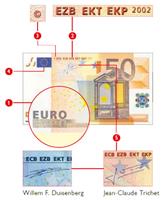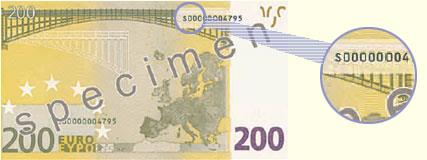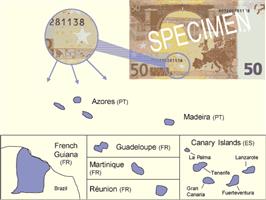
Design elements
- the name of the currency - euro - in both the Latin and the Greek alphabets
- the initials of the European Central Bank in five linguistic variants - BCE, ECB, EZB, EKT and EKP -
covering the then 11 official languages of the European Union
- the symbol © indicating copyright protection
- the signature of the President of the European Central Bank
- the flag of the European Union
- the signature of the President of the European Central Bank Euro
Signature Change
All euro banknotes of any denomination bear the signature of the President of the European Central Bank Euro:
- Willem F Duisenberg, the first President of the European Central Bank
- Jean-Claude Trichet, who succeeded him on 1 november 2003
- Mario Draghi, third president of the European Central Bank as from 1 November 2011
Eurozone country - members
Country codes
The central bank that commissioned the printing of a banknote (but not necessarily the country of printing)
is indicated by a letter or country code preceding the serial number.

This particular banknote, bearing the letter 'S', was printed for the Banca d'Italia. The country codes are listed below.
Uncirculated euro banknotes issued by the Banque centrale du Luxembourg bear the code of the central banks of the countries where the banknotes for Luxembourg are produced.
Printer codes
Each euro banknote has a printer's mark, consisting of 1 letter - 3 digits - 1 letter - 1 digit.

The first letter tells us which printer printed this note:
| Letter | Location | Country |
|---|
| F | Osterreichische Banknoten und Sicherheitsdruck GmbH, Wien | Austria |
| T | Banque Nationale de Belgique, Bruxelles | Belgium |
| D | Setec Oy, Vantaa | Finland |
| E | Francois Charles Oberthur Fiduciaire, Chantepie | France |
| L | Banque de France, Chamalieres | France |
| P | Giesecke & Devrient, Munchen/Leipzig | Germany |
| R | Bundesdruckerei, Berlin | Germany |
| N | Bank of Greece, Athens | Greece |
| K | Central Bank of Ireland, Dublin | Ireland |
| J | Banca d'Italia, Roma | Italy |
| G | Johan Enschede en Zonen, Haarlem | Netherlands |
| H | De La Rue, Gateshead | United Kingdom |
| U | Valora, Carregado | Portugal |
| M | Fabrica Nacional de Moneda y Timbre, Madrid | Spain |
The three digits following the first letter are the reference number of the printing plate. Each printer has started
with plate 001 for each value. When this plate is worn out or damaged it will be replaced by plate 002, etc.
The last part of the printer's mark (a letter and a digit) indicates the position of a note in the printed sheet.
The letter indicates the column, and the digit indicates the row. The smallest and the largest sizes of printing-sheets
known are:
- EUR 5: 8x4 (32 notes) and 10x6 (60 notes)
- EUR 10: 7x4 (28 notes) and 9x6 (54 notes)
- EUR 20: -- same --
- EUR 50: 5x4 (20 notes) and 8x5 (40 notes)
- EUR 100: -- same --
- EUR 200: 6x4 (24 notes) and 8x5 (40 notes)
- EUR 500: 6x4 (24 notes) and 7x5 (35 notes)
The letter indicating the column thus can vary from A to (maximum) J and the digit indicating the row thus can vary from
1 to (maximum) 6, depending on the size of the printing-sheet.
Map of Europe
The banknotes show a geographical representation of Europe. It excludes islands of less than 400 square kilometres
because high-volume offset printing does not permit the accurate reproduction of small design elements.
The tiny boxes near the bottom of the banknote show the Canary Islands and some overseas territories of France where
the euro is also used.
